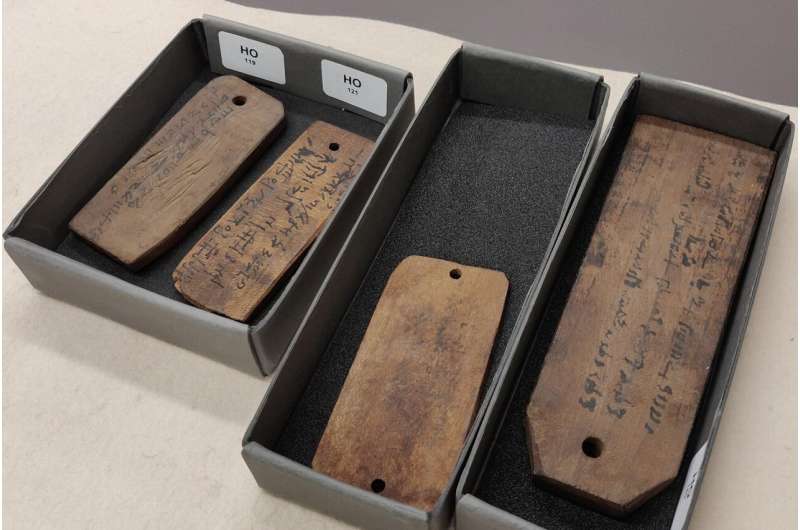This article has been reviewed according to Science X's editorial process and policies. Editors have highlighted the following attributes while ensuring the content's credibility:
fact-checked
trusted source
proofread
Mummies provide the key to reconstruct the climate of the ancient Mediterranean

Swiss scientists are reconstructing the climate of the ancient world using small wooden artifacts hung on mummified remains.
Throughout history, the Earth's climate has undergone natural fluctuations. Although insignificant compared with the current crisis, these fluctuations would nevertheless have been enough to make and unmake empires. According to recent studies, they would have contributed first to the rise of the Roman Empire and then to its fall. Basel- and Geneva-based scientists are endeavoring to reconstruct the climate of Roman-governed ancient Egypt in a bid to better understand the effects it had on the history of a region or empire. Their work is published in International Journal of Wood Culture.
The team is aided in its tasks by remarkable "Rosetta stones" in the form of wooden labels attached to Roman-era mummies. Before sending their deceased loved one to the embalmer, families would attach a label bearing the dead person's name, the names of their parents and sometimes a short religious message to the body. The labels were a way of identifying the deceased, who would no longer be recognizable once wrapped in their bandages, and ensuring that embalmers did not mix bodies up.
A wealth of information in museums
The wooden labels provide more information than just the identity of Pkyris, the defunct son of Besis and Senpnouth, or the late Tsenpetese, daughter of Panahib. They also contain precious information about the climate at the time because, like all wooden artifacts, they have growth rings. Each ring marks the passing of one year. Good years are indicated by broad rings, since the tree grew faster. Narrower rings can be evidence of years of drought.
A few pieces of wood are obviously not enough in themselves to reconstruct the climate of the time. It would be necessary to observe the same pattern in several dozen samples at least. The greater the number of overlaps, the more reliable the conclusions. In addition, to recreate the subtleties of climate fluctuation, it is essential to compare the growth rings of several tree species with different responses to climatic conditions such as drought or extreme heat.
"That's why mummy labels are ideal for our purposes," explains François Blondel, an archaeologist at the University of Geneva. "Not only are there thousands of them in museums around the world, they're made from lots of different tree species, such as pine, cypress, cedar and juniper."

Dating climate events
In the study, the researcher analyzed the ring sequences of over 300 labels. He then identified the overlaps—in other words, the cases where ring sequences match up with each other.
These overlaps provide an initial outline of what the climate used to be like in the eastern Mediterranean, in modern-day Lebanon, the Greek islands or the mouth of the Nile—the areas where the trees were harvested. There are a few good years here and an unfortunate succession of droughts there, but the actual dates are still unclear, François Blondel explains. "We can't yet assign a precise date to the rings and the events they record."
The next step going forward will therefore be to locate these events in history. With luck, the scientists will find a datable specimen. Then, by looking for overlaps with other labels from the same tree species and region, they should be able to pinpoint the exact date. If not, they will have to resort to radiocarbon dating.
By combining several samples of wood taken along the rings of the same specimen, it is possible to statistically reduce dating uncertainty—to virtually zero in the best-case scenario. The scientists still have to find the right specimens and, above all, obtain permission from museums for invasive radiocarbon analysis.
The search has only just started, explains Sabine Huebner, the leader of the SNSF project that is trying to reconstruct the climate of Roman Egypt. Huebner, a Professor of Ancient History at the University of Basel, coordinates the work of historians, archaeologists and climatologists. "Mummy labels are just a proxy tool that we are using to reconstruct the climate of Roman Egypt, the breadbasket of the Roman Empire, and understand how climate fluctuations influenced changes in society, government and the economy," she says.
It is a perfect example of how questions raised by ancient history can be of pressing importance to the modern-day world.
More information: François Blondel et al, Mummy Labels: A Witness to the Use and Processing of Wood in Roman Egypt, International Journal of Wood Culture (2023). DOI: 10.1163/27723194-bja10017
Provided by Swiss National Science Foundation




















